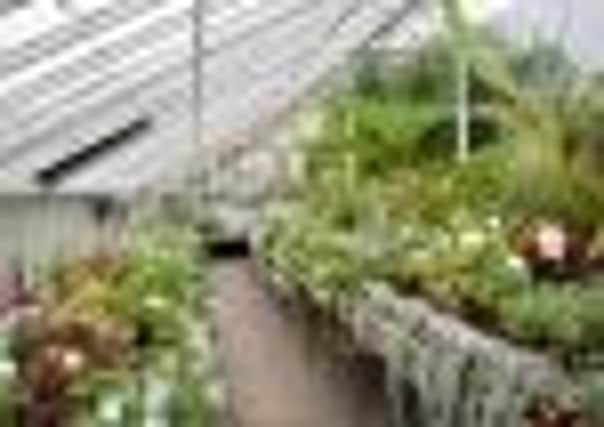Spectacular Drummond Castle gardens owe much to two head gardeners


With their formal box layout highlighted by the foliage of prunus, acers and sorbus they are widely regarded as one of the brightest jewels in the crown of Scottish gardens. Less well known, however, are their Victorian glasshouses, filled with gloriously coloured pelargoniums, tender climbers and vines.
Hidden away on the lower of the two terraces, the glasshouses are reached down the impressive flight of stone steps below the castle courtyard and across the first terrace with its historical 18th-century layout. Set against a south-facing stone potting shed in the former vegetable garden, the glasshouses are surrounded by the cutting gardens, cold frames and nursery beds.
Advertisement
Hide AdAdvertisement
Hide AdDawn Randlo, wife of head gardener Peter Randlo, enjoys working alongside her husband tending the glasshouses. Using the existing structure of tender varieties, this year she developed a colourful, red, white and blue colour palette, based on climbing Plumbago acuminate “Dawns”.
Her knowledge, Dawn says, was acquired from a life-long love of gardening, “and the privilege to live in some of the best gardens of Britain”. Peter, who trained with the National Trust of England, first worked at Mottisfont Abbey in Romsey, Hampshire. “This was a dream come true for me as I adore roses and Mottisfont holds the National collection of old roses.”
The couple moved to Warwickshire when Peter became head gardener for the National Trust property Packwood House in Warwickshire. “I took advantage of an opportunity to develop my skills from what was a hobby into gaining a City & Guilds qualification in Floristry from Solihull College,” says Dawn.
Fifteen years ago when the couple arrived at Drummond, Peter was thrilled to find the glasshouses, reputed to date from about 1850, almost intact. “The various parts of the ironwork such as heating pipes, glass opening mechanisms and heating grilles along the floor are all original,” he explains.
There were so many important areas in the gardens that the glasshouse was not always high priority. Dawn, who is employed in the garden on a seasonal basis, also started to volunteer in the glasshouse, where there was a good collection of plants. “There are basic requirements such as watering, feeding and pest control, but I just couldn’t help myself and rearranged a few things.”
In this she found her floristry skills useful. “My training taught me to follow the basic rule of design; colour, texture, height and depth. I stick to what I was taught about having blocks of colour for impact and not spreading plants too thinly.”
The most important technique is to stand back and imagine you are a visitor walking into the glasshouse for the first time. “Ask yourself what you see,” she says. “I like the plants to complement each other and the colours to flow.
“I didn’t personally introduce many new plants but I took advice from Peter and took cuttings of Lady Willoughby’s favourites, especially the geraniums.” Trial and error has taught Dawn to stick to the plants that flourish. Favourites include scarlet Geranium “Paul Crampel” for its bright colour and climbing, and pink “Madame Salleron” grown up the glasshouse wall for the impact of its flowers and variegated foliage.
Advertisement
Hide AdAdvertisement
Hide AdDawn stresses the importance of the glasshouses in raising young plants. Here, every year about 4,000 young antirrhinum plants in the red and yellow Drummond colours are grown for display in the parterre. This requires the expertise of the permanent garden team. “We have also experimented with companion planting to discourage pests, for example using lavender plants in between the young plants and cuttings.”
The glasshouses, Peter points out, are used continually throughout the year with various peak times. Summer bedding plants are followed by the production of grapes, figs and peaches, and, later still, the wooden shelves are used to process harvested vegetables such as onions and potatoes, before storage. “This is the purpose it was built for and I am sure it is the purpose with which it will continue.”
Currently the Grade A listed glasshouses are in the process of a five-year restoration programme, during which time every single piece of timber will be replaced with hardwood. Peter explains that these major repairs are almost certainly the most comprehensive ever undertaken at Drummond and are essential to the maintenance of the structure along with the attached stone building. “Painting,” he continues, “is done on a regular five-year cycle. The hardwood is painted using a final top coat that allows the wood to breath while protecting it from the elements.”
When asked about future plans, Dawn is characteristically modest. “I hope to return as a seasonal gardener next year and be given another opportunity to continue working with the team at Drummond.” If additional proof were needed of the couple’s devotion to these gardens it comes at the end of our interview when Peter says, “We are both keenly interested in keeping the spirit of such places alive.”
• Drummond Castle Gardens is owned by the Grimsthope and Drummond Castle Trust: Muthill, Crieff. The gardens are open from April to October (www.drummondcastlegardens.co.uk)